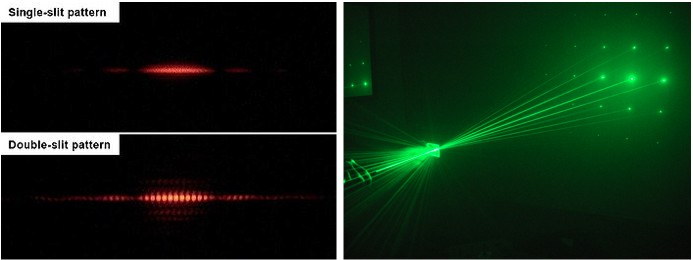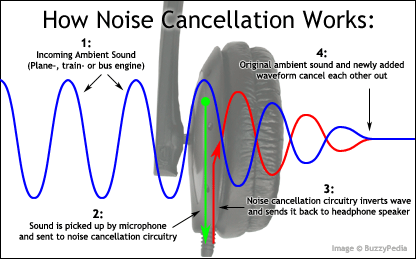Physicist: The wave-like property of particles allows you to do a lot of cute things with particles that would otherwise seem impossible, but making a particle disappear isn’t one of them. You can use destructive interference to make it very unlikely to find a particle in particular places, which is exactly what’s happening in the double slit experiment, and is also the basis behind how “diffraction gratings” work.

The wave nature of things (in this case light) can be used to get it to go places it normally wouldn’t (right), or not go places it normally would (left). By using two slits you can interfere the light waves to cause the light to never show up in places where it would when passing through one slit (dark bands in in the lower left).
But in order to destroy a particle using destructive interference you’d need to ensure that there was nowhere left with any constructive interference. In the pictures above there are dark regions, but also light regions. Turns out there are some very solid mathematical principles and physical laws that don’t allow waves to behave that way (not just waves in particle physics, but waves in general), not the least of which is the conservation of energy. So, say you’ve got some kind of waves bouncing around (light waves, sound waves, particle fields, whatever), and you want to make new waves to cancel them out. You can certainly do that, but only in small regions.

How noise canceling headphones work. Rather than destroying sound around them, they cancel out the sound on one side that’s coming from the other. But ultimately they’re just speakers that make the environment louder overall.
The new waves add energy to the overall system, so no matter how hard you try to cancel things out, you’ll always end up adding energy somewhere, it’s just a question of where. Noise canceling headphones are a beautiful example. They actively produce sound in such a way that they destructively interfere with sound waves coming from nearby, in the anti-headward direction. Although they create quiet in the ears, they create noise everywhere else. There’s no getting around it.

Say you’ve got a bunch of noise bouncing about. Noise canceling techniques can create a quite region, but end up generating more total noise outside of that region.
Similarly, you could try to kill off particles by creating new waves in the particles field (each kind of particle has a corresponding field, for example light particles are called “photons” and they have the electromagnetic field) that cancel out the particle. You can totally create a particle “dead zone”, assuming you know exactly what the particle’s wave form is. Headphones need this as well; you can’t just get rid of sound, you first need to know exactly what the sound is first. However, anything you try will end up adding more particles , and won’t destroy the particle you’re worried about anyway, just redirect it.
There are a few ways to destroy a particle. You can chuck it out (which is as good as destroying it, for most practical purposes), or you can annihilate it. But annihilation is a bit of a cheat; you just put a particle in a chamber with its anti-particle and let nature take its course. But that doesn’t use waves and interference (in the way we normally think of waves), they just combine, disappear, and leave behind a burst of energy. But not in a cool, wavey interferey, kind of way.
The pictures at the top of this post are from here and here.







i want to know if i can split G, into two forces,timedilational and non-time dilational, to explane AGNs with no blackhole, a object dwaring M, towards it but rejecting it throught magnetic lines, so no critical M, occurs, no neutron or e, degenerancy, but G, of the galactic disc, extreme on object but weak G, in core preventing collapse to one central point, so no blackhole occurs,
sagetarius A, is i beleive one such object many mln M. may explane that stars came before galaxys, the very first mega stars
events can involve the creation and annihilation of particles
but making a particle disappear isn’t one of them
won’t destroy the particle you’re worried about anyway, just redirect it
There are a few ways to destroy a particle
But in order to destroy a particle
Which one of these statements is true?
So is my understanding of waves correct that by introducing other waves like for cancellation or harmonic amplification (like how a microwave oven resonates because o it’s dimensions) you are adding energy to a system in a certain manner to affect the amplitude of a wave? So the best you could hope for is to lower the crests and troughs of a target photon so you might get a very flat photon? It would still have the same wavelength? (Unless harmonic interference?) the side effect would be that you would have two low amplitude photons that would impact the same surface? (If you were lining up their waves to phase cancel)?
…also makes me think about noise canceling headphones. The canceling wave is being generated by the speaker in the headphones so if you are trying to cancel something in a frequency range that the headphones have a crappy response curve to ( like 13.75Hz infra-sound) or the incoming waves have way to high of an SPL (like 130 dB) the headphones aren’t going to cancel jack, right?